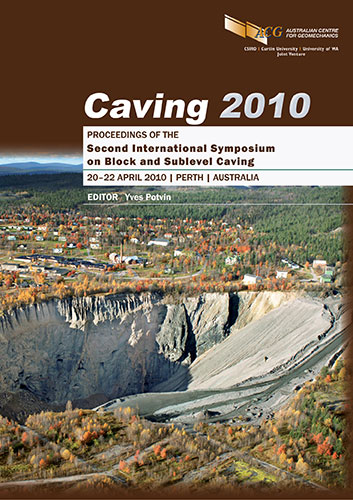Sensitivities in the numerical assessment of cave propagation

|
Authors: Sainsbury, BL |
DOI https://doi.org/10.36487/ACG_rep/1002_36_Bsainsbury
Cite As:
Sainsbury, BL 2010, 'Sensitivities in the numerical assessment of cave propagation', in Y Potvin (ed.), Caving 2010: Proceedings of the Second International Symposium on Block and Sublevel Caving, Australian Centre for Geomechanics, Perth, pp. 523-535, https://doi.org/10.36487/ACG_rep/1002_36_Bsainsbury
Abstract:
The accurate assessment of cave initiation and propagation is of critical importance to the planning of any new caving operation. For this reason, the use of numerical models for simulation of the undercutting, draw, propagation and surface subsidence processes are becoming more commonplace. This paper describes the application of a numerical caving algorithm that has been developed within the industry funded Mass Mining Technology (MMT) project. The caving algorithm allows a cave volume to evolve as a result of the in situ geomechanical conditions and the imposed production schedule. It has been validated at a number of different caving operations. The effect of the in situ geomechanical conditions and imposed production schedule on cave behaviour has been studied by conducting a series of numerical simulations of a conceptual block cave mine. The results are compared to traditional empirical methods for predicting caveability.
References:
Brady, B. and Brown, B. (2004) Rock mechanics for underground mining, Third Edition, Dordrecht, London, Kluwer Academic Publishers 2004, xviii, 626 p.
Board, M. and Pierce, M. (2009) A review of recent experience in modelling of caving, International Workshop on Numerical Modeling for Underground Mine Excavation Design June 28, 2009 Asheville, North Carolina in conjunction with the 43rd U.S. Rock Mechanics Symposium.
Boyum, B.H. (1961) Subsidence Case Histories in Michigan Mines, Fourth Rock Mechanics Symposium, Pennsylvania State University.
Cundall, P.A. (2005) Caving Mechanics Task 1-Scoping Study, Report to MMT Technical Director, Julius Kruttschnitt Mineral Resource Centre.
Duplancic, P. and Brady, B.H. (1999) Characterization of caving mechanisms by analysis of seismicity and rock stress, in Proceedings 9th International Congress on Rock Mechanics, Paris, Balkema, Rotterdam, Vol. 2,
pp. 1049–1053.
Diederichs, M.S. (2000) Instability of Hard Rockmasses: The Role of Tensile Damage and Relaxation, PhD Thesis, University of Waterloo, 617 p.
Gilbride, L., Free, K. and Kehrman, R. (2005) Modeling Block Cave Subsidence at the Molycorp Inc., Questa Mine – A Case Study, Alaska Rocks 2005, in Proceedings 40th U.S. Symposium on Rock Mechanics (USRMS), June
25–29, Anchorage, 14 p.
Itasca Consulting Group, Inc. (Itasca) (2009) FLAC3D – Fast Lagrangian Analysis of Continua in 3 Dimensions, User’s Manual, Minneapolis, Itasca, Ver. 4.
Laubscher, D.H. (2000) Block Caving Manual, Prepared for the International Caving Study, Julius Kruttschnitt Mineral Resource Centre and Itasca Consulting Group, Brisbane.
Lorig, L. (2004) The role of numerical modelling in assessing caveability, International Caving Study, 2004.
Lui, T.Q. (1981) Surface Movements, Overburden Failure and its Applications, Coal Industry Publishing, China.
Panek, L.A. (1984) Subsidence in undercut-cave operations, subsidence resulting from limited extraction of two neighboring cave operations, in Geomechanical applications in hard rock mining, W.G. Pariseau (ed),
pp. 225–240.
Pierce, M., Young, P., Reyes-Montes, J. and Pettitt, W. (2006) MMT Project Caving Mechanics Report, ICG06-2292-1-T3-40.
Sainsbury, B., Pierce, M. and Mas Ivars, D. (2008a) Analysis of Caving Behaviour Using a Synthetic Rock Mass —Ubiquitous Joint Rock Mass Modelling Technique, in Proceedings 1st Southern Hemisphere International Rock Mechanics Symposium (SHIRMS), Y. Potvin, J. Carter, A. Dyskin and R. Jeffrey (eds), Australian Centre for Geomechanics, Perth, Australia, Vol. 1 – Mining and Civil, pp. 243–254.
Sainsbury, B., Pierce, M. and Mas Ivars, D. (2008b) Simulation of rock mass strength anisotropy and scale effects using a Ubiquitous Joint Rock Mass (UJRM) model, in Proceedings First International FLAC/DEM Symposium on Numerical Modelling, Minneapolis, USA, Minneapolis: Itasca.
Sainsbury, D.P. (2005) Investigation of Mining-Induced Subsidence at the Abandoned Grace Mine, Confidential Itasca report to New Morgan Properties, L.P. ICG04-2262-29.
Szwedzicki, T., Widijanto, E. and Sinaga, F. (2006) Propagation of a Caving Zone, A Case Study from PT Freeport, Indonesia, in Proud to Be Miners (MassMin 2004, Santiago, August 2004), Santiago: Mineria Chilena.
UNSW (1995) UNSW Pillar Design Outcomes, Issue No. 7, The University of New South Wales.
© Copyright 2024, Australian Centre for Geomechanics (ACG), The University of Western Australia. All rights reserved.
View copyright/legal information
Please direct any queries or error reports to repository-acg@uwa.edu.au
View copyright/legal information
Please direct any queries or error reports to repository-acg@uwa.edu.au